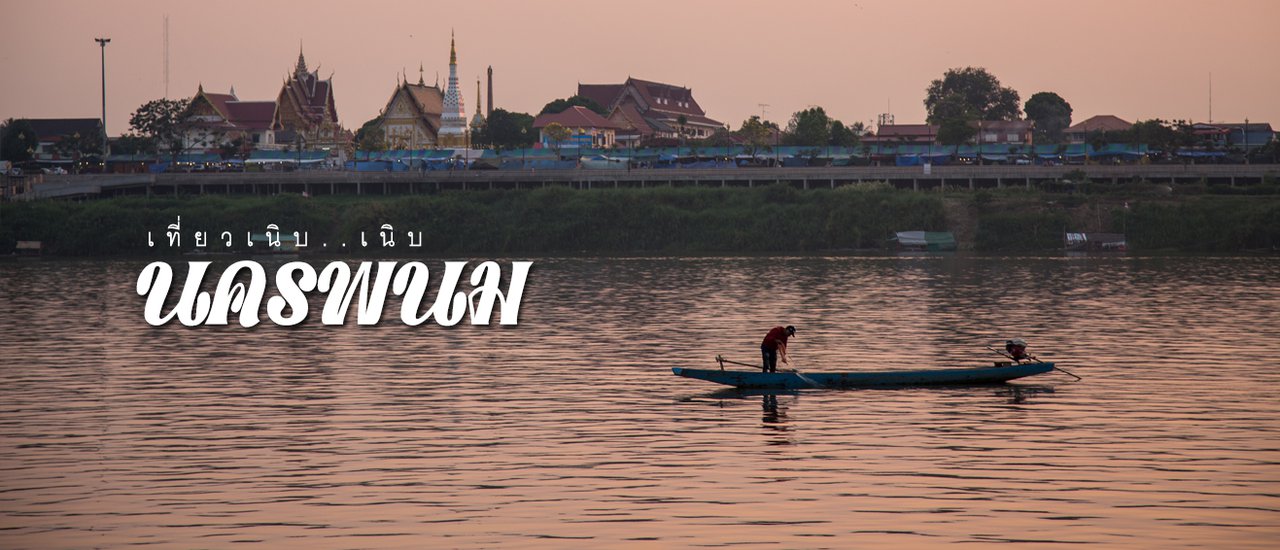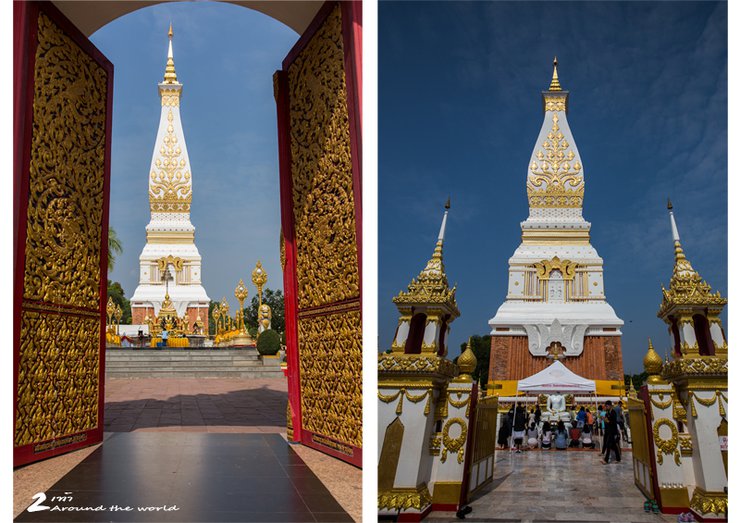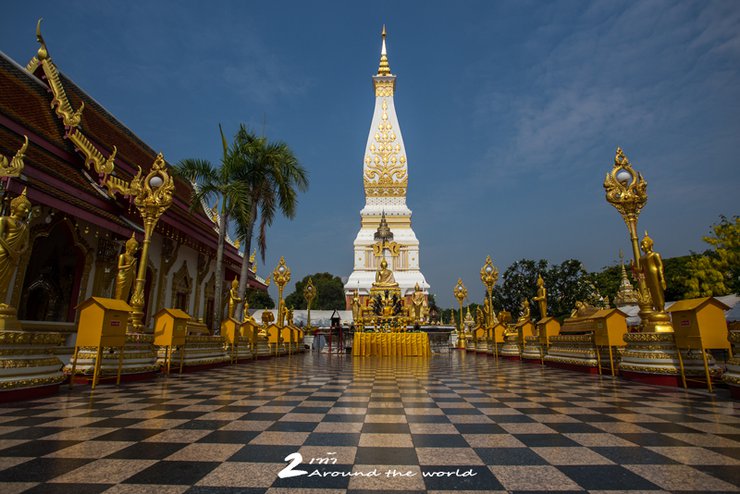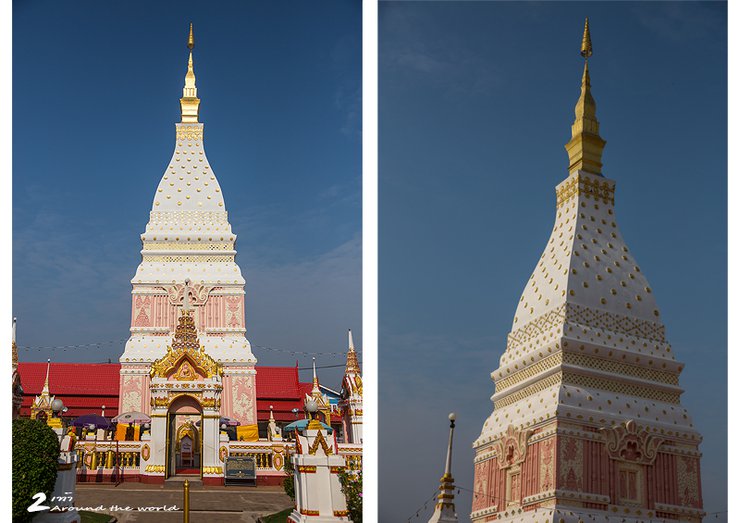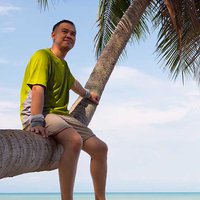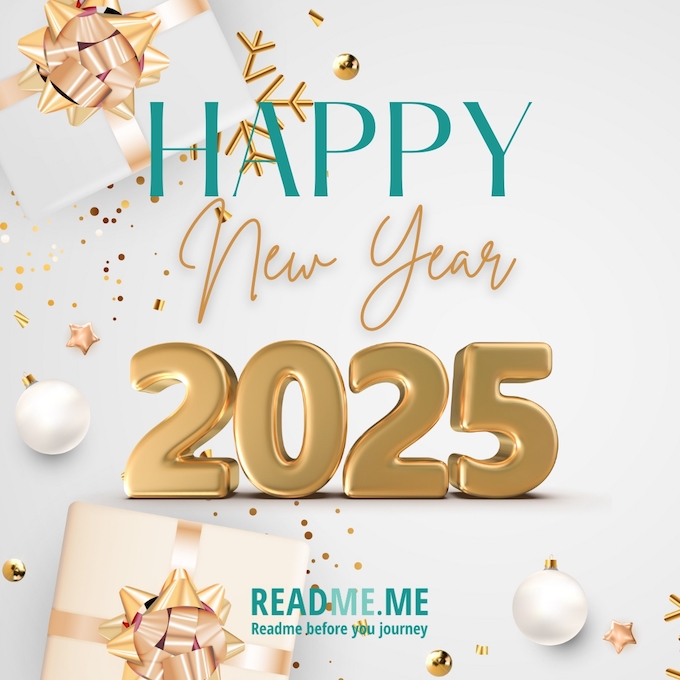
"The revered Phra That Phanom, diverse cultures, the beauty of the Reneu Tai people, the radiant fireboats, and the breathtaking Mekong River."
Nakhorn Phanom is a province with a diverse population, including Thai, Lao, Vietnamese, and Chinese people. This diversity is reflected in the province's tourist attractions. Let's explore what Nakhorn Phanom has to offer in terms of sights and tastes.
Let's start with Phra That Phanom as the first point. I believe that this stupa is very important to Nakhon Phanom Province. Because looking at the provincial seal of Nakhon Phanom, it is still the shape of Phra That Phanom.
**

The Phra That Phanom is located within the Wat Phra That Phanom Woramahawihan. The current stupa is a replacement for the original one, which was built between 1200 and 1400 CE by the 500 arahants led by the Venerable Maha Kassapa and various local rulers. In 1975, a series of strong storms caused the old stupa to collapse. Devout Buddhists from all over Thailand donated funds to rebuild the stupa according to the original design. The reconstruction was completed in 1979. The stupa enshrines the breastbone relic of the Buddha, along with tens of thousands of other precious objects.

Phra That Phanom is the birth year stupa for those born in the year of the monkey and the birth day stupa for those born on Sunday. It is a spiritual center for Thai people and Laotians alike. It is believed that those who come to pay homage will receive blessings and respect from others.
From Phra That Phanom, I headed to Renoo district to pay homage to Phra That Renoo.
**

**

Upon entering the grounds of Wat Phra That Renu, I was immediately captivated by the sight of the large pink stupa standing majestically beside the golden-hued temple. The voice of the temple guide echoed through the loudspeakers, inviting our group to participate in making merit with the temple. I excused myself to explore the interior of the ubosot first. Inside the ubosot, the Phra Ong Saen, a golden Buddha statue in the Lao style, sits in the samadhi posture. It was created before the construction of the Phra That Renu in 1917. The gold sheets used to cast the statue were donated by devotees from all over Renu Nakhon. Therefore, it is not inaccurate to say that the Phra Ong Saen is a revered symbol of Renu Nakhon.

**

After paying respects to the sacred Phra Ong Saen, we proceeded to the revered Phra That Renu Nakhon. This replica of the original Phra That Phanom, which tragically collapsed in 1975, stands as a testament to the enduring faith of the people. Though smaller in scale, Phra That Renu Nakhon holds immense significance. According to my research, the stupa enshrines sacred Buddhist scriptures, golden and silver Buddha statues, precious gems, and other valuable offerings donated by the rulers and citizens of Renu Nakhon. It also houses relics of the Buddha and revered arhats. While designated as the auspicious stupa for those born on a Monday, its pink hue might lead one to believe it is associated with Tuesday. Devotees believe that paying homage to Phra That Renu Nakhon bestows the blessing of a radiant complexion, as luminous as the moon's glow.
The next destination is Uncle Ho Chi Minh's house, which is not far from the airport.
**

**

Nestled amidst a verdant tapestry of diverse flora, this unassuming wooden house holds a significant place in history. Between 1924 and 1931, Ho Chi Minh, the revered President of the Socialist Republic of Vietnam, sought refuge under the benevolent auspices of His Majesty King Bhumibol Adulyadej of Thailand. During this period, Ho Chi Minh dedicated himself to the liberation of Vietnam, strategizing and preparing for the revolution against French colonial rule.

Uncle Ho relocated to Nakhon Phanom, seeking refuge with a close Vietnamese friend who shared his ideology. During their escape from Vietnam, Uncle Ho and his friend fled to separate locations. Uncle Ho changed his name and continuously relocated to avoid recognition. Meanwhile, his friend settled in Thailand and established a family there.


Historical experts will share stories about Uncle Ho's life and experiences during his time in Thailand.




The interior of the house is divided into three rooms: two bedrooms and a living room. It contains a desk and personal belongings used by Uncle Ho during his stay at this house.


The kitchen is separated from the main house. Inside, there are displays of kitchen equipment.

A rice-pounding machine used by Uncle Ho to pound rice himself.
This star apple tree was planted by Uncle Ho. Today, its branches spread wide, bearing fruit next to the house.

The cherry blossoms from Vietnam. At first, I thought they were fake flowers, but when I took a closer look, I realized they were real.

The lush greenery here is undeniable, with a variety of fruit trees like coconut, betel nut, areca nut, bottle gourd, and banana, as well as beautiful flowering plants like orchids and jasmine, filling the air with their fragrant aroma.

This house belonged to Uncle Ho's friend and is currently inhabited by his descendants. The space beneath the house serves as a small souvenir shop.
Admission to Uncle Ho's house is free. However, if you would like to support the site's continued operation and educational efforts, you can contribute to the cost of utilities by donating to the donation box or purchasing a souvenir or two.
Near Uncle Ho's house is the Ho Chi Minh President Memorial Site. Inside, there is a museum building that collects historical stories about Uncle Ho's struggle for independence. There are wax figures and a replica of Uncle Ho's house. I think since we're already here, it's much better to see the real Uncle Ho's house.
An army marches on its stomach. I haven't eaten anything since this morning, but I have to hold back and save my stomach for the famous Khao Kriap Pak Mo in Nakhon Phanom, at the renowned Sri Thep Khao Kriap Pak Mo restaurant.

Sri Thep Crispy Pancake Shop is located in the city center on Si Thep Road, opposite Sri Thep Hotel. The vendors make the crispy pancakes in front of the shop, using a very large pot. I'm used to eating small crispy pancakes with a filling of stir-fried minced pork, peanuts, and chopped pickled radish, but the crispy pancakes here are quite large. The filling is stir-fried pork with spring onions, served with a sweet dipping sauce with fresh chopped chilies.
The difference between each menu of Khao Kriap Pak Mo Sri Thep lies in the dough and the wrapping, but the filling is the same for all menus. How are they different? Let's take a look.

"Pak Mor" is a simple dish made with a plain flour wrapper and a variety of fillings.

"Mouth pot with egg" involves mixing egg into the dough, wrapping it into a cylindrical shape similar to "kway teow lod" (rice noodles).

"ปากหม้อห่อไข่" involves incorporating eggs into the batter, similar to "ไข่ยัดไส้," but with a distinct wrapping technique.


"Fried Egg in a Crispy Cup" differs from the "Egg-Wrapped Crispy Cup" in that the egg is not mixed into the batter but rather cracked directly into the cup. This results in a runny yolk that resembles flowing lava when the dish is eaten.
All four dishes have soft and tender dough, which is very delicious.

For those who enjoy unconventional flavors, this dish is a must-try. "Khao Kriap Pak Mo" features a crispy rice cracker that envelops the soft dough, creating a delightful contrast in textures. The combination of the cracker's crunch and the dough's chewy softness is truly unique and satisfying. This dish is a personal favorite, and I highly recommend it.
In addition to the main dish, there are also side dishes such as pickled vegetables and fermented pork. The price of the crispy pancake is not expensive, only about 30-35 baht per menu. If you come with a group of people, it is recommended to order several menus to share, like what I ordered. This way, you can enjoy a variety of flavors. This is another restaurant that you should not miss if you visit Nakhon Phanom.
Our bellies full, we continued our journey to the next destination, the "Phraya Si Satta Nakarat", a new sacred landmark of Nakhon Phanom, located not far from the rice cracker shop.


The enduring belief in "Naga" among Thai people, particularly in the Northeast region, has fostered a deep faith and reverence for these mythical serpent deities. During the "Ok Phansa" festival, the mysterious phenomenon of "Naga fireballs" rising from the Mekong River reinforces this belief, perpetuating the shared faith in Nagas among Thais and Laotians.
Even the Loy Krathong festival, a renowned tradition of Nakhon Phanom province, is linked to the Naga belief. Tracing the history of the Loy Krathong festival reveals that it is held to worship the footprint of the Buddha at the bank of the Nam Tha Mahani River, the abode of the Naga. The Buddha went to the bank of the Nam Tha Mahani River to preach to the Naga in the underworld, and the Naga requested the Buddha to leave his footprint at the bank of the Nam Tha Mahani River. Later, the gods, humans, and all creatures came to worship the Buddha's footprint, which has continued as a beautiful tradition.


The Seri Satta Nagara statue, cast in bronze and weighing 9,000 kg, depicts a seven-headed naga coiled around itself. It stands on an octagonal base, 6 meters wide, and reaches a total height of 15 meters, including the base. The statue, prominently positioned by the Mekong River, spouts water and is a popular destination for tourists and locals alike, who frequently visit to pay their respects and make offerings.
Not far from the Phra Sri Satta Nakarat statue is Wat Pho Si, a temple housing the revered Phra Thong, a golden bronze Buddha statue in the Mara-Vijaya posture, a sacred guardian of Nakhon Phanom.

The Golden Buddha statue is enshrined in the Golden Buddha Hall. It is an ancient Buddha statue created by the Lan Xang school of art, dating back to the early Ayutthaya period. Originally, the Golden Buddha was enshrined at Wat Ban Hom, Tambon Achan Samart. However, the governor of Nakhon Phanom deemed it unsafe and difficult to maintain, so it was moved to Wat Pho Si, where it remains today. As it is a sacred Buddha statue of the city, it is heavily protected against theft. A cage has been built around it, covered with glass and locked with three layers of padlocks.



The side of the golden pagoda is the Sim (ordination hall), inside which is the principal Buddha image.
Situated just a short distance from Wat Pho Si, Wat Maha That stands as another significant temple in Nakhon Phanom.


The Maha That Temple houses the Nakhon Si Thammarat Chedi, the chedi for those born on Saturday. It is a square-shaped chedi, 4.85 meters wide on each side and approximately 24 meters high. It follows the design of the original Phra That Phanom. The chedi was built using relics from the original chedi. It is believed that those who pay homage to the Nakhon Si Thammarat Chedi will receive blessings of happiness, prosperity, wealth, good health, increased charisma, power, and authority.
From Wat Maha That, I continued to Wat Okat Sri Bua Ban, which is not far from Wat Maha That.


Wat Okas Sri Bua Ban is another ancient temple in Nakhon Phanom, built during the Sri Khotrabun Kingdom. In the center of the temple, there is a hall enshrining Phra Tiew and Phra Thiam.


The Phra Tiew Buddha statue is a wooden statue covered in gold leaf, standing approximately two rulers tall. It is over 1,300 years old, created by the ruler of Nakhon Si Thammarat in 1328 CE. After a misunderstanding that the statue had been destroyed by fire, a replica was made (without the gold leaf, but with gold paint). Later, the original Phra Tiew was found floating in the Mekong River, resulting in a pair of statues: the original Phra Tiew (right) and the replica (left). Both statues were originally housed at Wat That, but were moved to Wat Okat Sri Bua Ban over 250 years ago.

From Wat Okat Sri Bua Ban, I headed to the Vietnamese Clock Tower Memorial. It is a clock tower built by the Vietnamese people as a memorial to the people of Nakhon Phanom when they moved back to their hometown in Vietnam. It is like a thank you from the Vietnamese people to the Thai people.


Our next stop is the National Library of Nakhorn Phanom, a beautiful building constructed in 1915 during the reign of King Rama V. The Renaissance-style architecture exudes a classic charm. Interestingly, the library was built using convict labor and originally served as the provincial city hall.
From the National Library, we took a short ride, and before the air conditioning had even cooled down, we arrived at our next destination: the Church of St. Anne-Nong Saeng.



Saint Anne-Nong Saeng Church, despite its unusual name, is one of the oldest and most beautiful Christian churches in Nakhon Phanom. Built in 1926, the original church was destroyed by French bombing during the Franco-Thai War. A new church was subsequently built to serve the religious needs of the Christian community. Before Christmas, Christians from various communities in Nakhon Phanom gather at the church to display their handcrafted stars, creating a spectacular sight. Unfortunately, the church was closed during my visit, so I was unable to capture the interior.


Adjacent to the church is a Catholic rectory built around 1952 by Father Edouard Nampla. Later, it was established as the Father Edouard Nampla Foundation. The building is constructed in the Colonial architectural style, made of brick and mortar, and painted a beautiful yellow on the exterior. Some of the building materials were imported from Saigon, Vietnam.
After a long drive from St. Anne's Church - Nong Saeng, we took a 15-minute nap and arrived at our next destination, the 3rd Thai-Lao Friendship Bridge.



The third Thai-Lao Friendship Bridge connects Thailand with the Lao town of Thakhek in Khammouane Province. The bridge, which cost 1.723 billion baht to build, is 780 meters long and took two years to complete. Her Royal Highness Princess Maha Chakri Sirindhorn presided over the official opening ceremony with the Vice President of the Lao People's Democratic Republic on November 11, 2011, at 11:11 am, a beautiful and memorable date. The bridge serves as a transportation route for trade and tourism, connecting Thailand, Laos, Vietnam, and southern China.
Due to time constraints, I was unable to cross over to the Lao side. I could only request permission from the officials to walk to the foot of the bridge to take pictures.
My next program is a sightseeing cruise along the Mekong River, bordering Thailand and Laos. The pier is located at Lan Khone Muang, near Wat Okat Sri Bua Ban. The boat departs at 5:00 PM.

I planned to arrive at the pier around 4:00 PM to secure a seat on the boat. While waiting for the boat to depart, I decided to do some light shopping at the Indochina Market.


The Indochina Market is located next to Wat Okat Sri Bua Ban and directly opposite the pier. Although the selection of goods may not be extensive, it's a pleasant place to stroll and pass the time.


At the pier, the visible vessel is a double-decker boat of considerable size, designed to transport tourists for sightseeing along both banks of the Mekong River. Onboard, snacks such as meatballs and beverages are available for purchase.

I recommend going up to the second floor. The view is much more open and the air is much fresher. It's not as stuffy as downstairs. You might have to endure the sun for a bit at first, but after a while, the sunlight will gradually disappear.

The Vietnamese Memorial Clock Tower is visible.

During my visit, the sky was not very clear, but it turned out to be a blessing in disguise. The lack of strong sunshine made the boat ride more enjoyable. Along the way, I saw local villagers fishing.

The boat turned around at the area of St. Anna Church - Nong Saeng and took us across the Mekong River to the Lao side. As the boat approached the Lao shore, I could feel the coolness of the air from the Lao side. This could be because the Lao side has a lot of trees, which creates a lot of moisture.

On the Lao side, there is also fish farming in cages.

Kham Muen Pier, Tha Khaek Border Checkpoint

Returning to the Thai side, the atmosphere was truly excellent.

The sun is setting, casting a warm, golden glow on the horizon.

Round-trip boat tour on the Mekong River
This boat tour offers a unique opportunity to experience the beauty of the Mekong River and learn about the local Thai and Lao cultures. The tour lasts approximately one hour and covers a distance of 8 kilometers. During the tour, knowledgeable guides will provide informative and entertaining commentary. The cost of the tour is 50 baht per person.
For larger groups who wish to take the tour before 5:00 PM, it is possible to charter the entire boat for 1,000 baht per hour. This means that the cost remains the same regardless of the number of people in the group, whether it is two people or forty people.
After a long day, it's time to rest. Tonight, I'm staying at The River.




Upon entering the property, the dining room will be on your left. Continue past the dining room to reach the guest rooms. A spacious parking lot is located in front of the building.

Every room offers a view of the Mekong River.

The modern-style lobby offers comfortable seating for guests to relax while waiting for check-in or check-out.



The room is a comfortable size, neither cramped nor overly spacious. The decor is charming, and the amenities meet the standards of most hotels, including a safe, refrigerator, electric kettle with tea and coffee, LCD TV, hairdryer, and free Wi-Fi.


The bathroom features a see-through design with a glass wall separating the wet and dry areas. It is equipped with a rain shower and a bidet spray attached to the toilet.

Let's take a look at the atmosphere around the hotel. In front of the hotel, there are stylish photo corners waiting for guests to come and pose for pictures with a wooden sign that highlights the selling point of Nakhon Phanom: "Nakhon Phanom, the happiest city in 2014".

Behind the hotel, there is a red mailbox with a sign that says "Nakhon Phanom". It's quite stylish.



Across the Lobby is a small coffee shop called "River Coffee".

Evening atmosphere.
After a refreshing break, it's time to enjoy a delicious dinner.
This evening, we will be dining at Sabai Dee restaurant, which is located near the clock tower.

While waiting for my food, I took a walk to take some photos to kill time. This street is a walking street along the Mekong River. There will be vendors selling goods in the evenings on Fridays and Saturdays. Unfortunately, the day I went was not a day when there were vendors selling goods. However, even if it is not Friday or Saturday, tourists can still come and have dinner, listen to soft music, and enjoy the atmosphere of this street. There are many stylish restaurants to choose from.


From Sabai Dee Restaurant, it takes less than 200 meters to reach the Vietnam Memorial Clock Tower. The atmosphere in the evening is beautiful in a different way. There are lights shining on the clock tower, making it change colors.

The photo shoot took quite a while, so I should head back to the restaurant soon to avoid missing the meal with everyone else.

The meal began with a dish of glass noodles baked with large prawns, seasoned to perfection. This dish was priced at 150 baht.

This dish features a generous portion of large, perfectly cooked cockles, bursting with fresh herbs. I devoured nearly half of it myself! It's a steal at only 120 baht.

The deep-fried fish with Mieng leaves boasts a delightful flavor. The fish is cut into thick, tender pieces, and the Mieng sauce is delicious. However, the accompanying condiments are somewhat limited. The dish is priced at 150 baht.

Deep-fried small soft-bone fish with garlic. The fish is not too big and is fried to perfection, making it crispy. You can eat the whole head. The price is 200 baht.

The Wagyu beef marinated in wasabi was slightly tough, and the wasabi flavor was not very pronounced. The price was 150 baht.

The sour soup with grilled fish, "Pla Pao," offers a variety of fish options. I opted for the "Pla Pao" to experience a local delicacy. The "Pla Pao" has thick skin, resulting in a satisfying crunch when chewed, similar to pork rind. For those seeking a unique culinary adventure, this dish is worth a try. The sour soup broth is perfectly balanced, and the price is reasonable at 250 baht.

Concluding with sticky rice with mango, the sticky rice is molded into a heart shape and costs 80 baht.
For Sabai Dee Restaurant, both the price and taste are considered acceptable. Each dish is reasonably priced compared to the quantity and quality of the food. The members of the trip today have given it a pass. After dinner, we should probably go back to rest, because we've been tired all day.
The golden morning light began to flood into the room. I wasted no time in waking up to admire the view from the balcony.


The main reason I chose to stay at The River was to watch the sunrise from my balcony. If you're feeling lazy, you can also watch the first light of day from your bed. The locals go out fishing early in the morning, and the golden light gradually shines through the trees on the Lao side. Even though the sky wasn't completely clear, I could still feel the beauty of the first light.
After soaking up the atmosphere, it's time to head down for breakfast.






The hotel provides breakfast at the River Bar, a separate building located at the front of the hotel. The River Bar features a rustic, exposed-concrete design. The breakfast buffet offers a decent selection of options.



This morning, I did not indulge in the buffet line, but instead opted for the egg pan and Vietnamese noodle soup station. The chef prepares the dishes according to customer orders, ensuring that we enjoy piping hot food straight from the stove.
While budget-friendly accommodations in Nakhon Phanom are readily available for around 500-600 baht, I opted for a slightly higher price point of 990 baht per night. This decision proved worthwhile, as it granted access to a significantly enhanced breakfast experience and, most importantly, breathtaking views of the Mekong River. The quality of the accommodations exceeded expectations, offering modern, spotless rooms with stunning vistas. The breakfast buffet was exceptional, and the overall value for money was outstanding. It's worth noting that the hotel has five floors, with rooms on the lower level priced at 790 baht and those on floors 2-5 priced at 990 baht (for standard room types).
While Nakhon Phanom boasts numerous significant landmarks, my limited one-day, one-night stay allowed me to explore only a fraction of its tourist attractions. I sincerely hope to return and complete my pilgrimage to all the birthdate-associated pagodas.
For further support and updates on my work, please visit my Facebook page at https://www.facebook.com/unclegreenshirt.
ลุงเสื้อเขียว
Tuesday, October 8, 2024 10:27 AM

